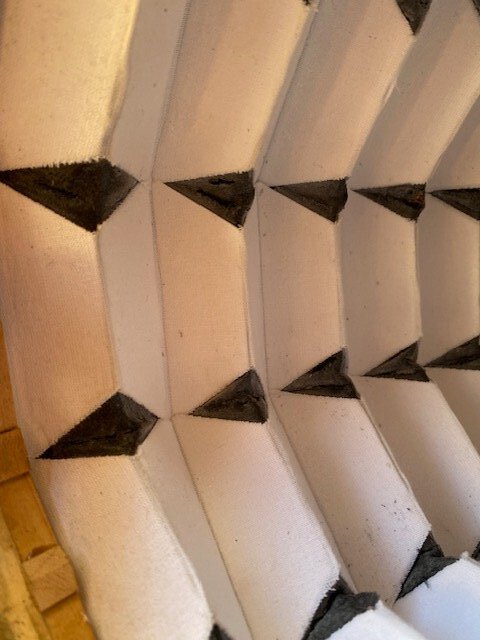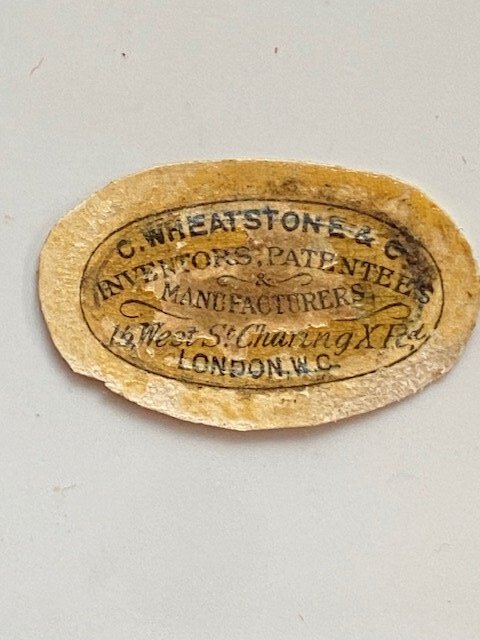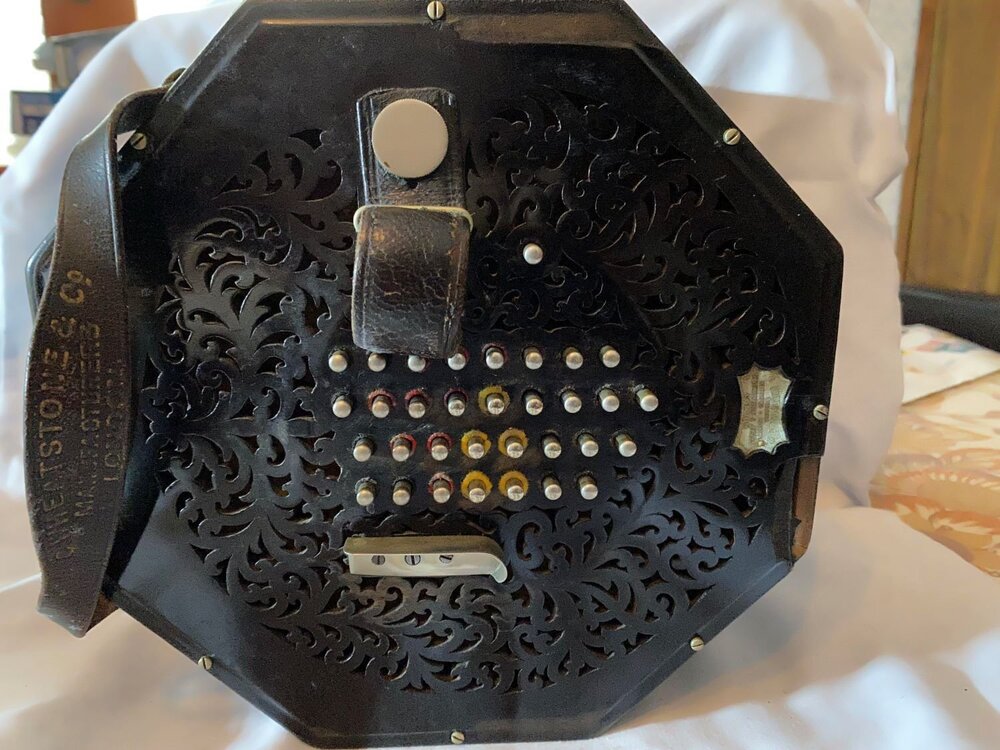-
Posts
1,670 -
Joined
-
Last visited
Posts posted by SteveS
-
-
I have an Aeola that has had some time recently new bellows fitted. The problem is that the bellows folds sag a lot when being played.
I inspected the bellows interior, and it appears as though the supporting fabric for the bellows is missing on both the outside and inside fold ridges - this probably accounts for the instability of the bellows. The top leather runs is all that binds the cards together - no fabric support binding - and the leather stretches causing the bellows to sag.
Overall, the bellows are of poor quality and could probably benefit from being replaced.
Here is a picture:

Before I replace the bellows, I think I'd like to try reinforcing the inside fold ridges with fabric to see if that helps eliminate the sagging of the bellows folds.
Any suggestions on the type of glue I might use?
I want to use a glue that is flexible, strong, but grabs quickly, and sets in a reasonable amount of time since I'll probably have to hold the fabric in place by hand until it sets.
I've tried PVA and hide glue.
-
The original hole was smaller than it is now - as the post was *pressed* into the hole during manufacture, the hole size increased.
Friction between the wood fibres and the brass post was what kept it in place.
Here's how you fix it:
1) using a piece of hard wood (I use sycamore which is what the original button board is usually made from) and fashion a small filler piece. Leave a small hole to accept and locate the pivot post when refitting.
2) fit the filler piece into the button board - glue the filler in place with PVA glue (or a tiny dab of super glue - this is one of the few cases I'd suggest using super glue on a concertina). Allow the glue to set thoroughly - at least 24 hours.
3) Make a few serrations on the tang of the pivot post using the sharp edge of a medium file - this is to help increase the friction between tang and wood (don't over do it).
4) *Press* the post into the hole you created/left in 1) above.
I hope this helps. -
It does look as though the springs have forced the pivot post to back out - as Dave says above.
My repair is to ensure the tangs on the pivot post will grip, then to partially fill the hole with a small piece of sycamore.
Then press the pivot post into the hole (I use an arbor press) - do not hammer since this may cause the button board to crack.
-
I have on my bench at the moment a 48 key Wheatstone baritone, brass reeds, rosewood ends.
So far the ends have been repaired and beautifully refinished. New valves.
I'm working on new pads, new thumb straps, bellows rebuild, action rebuild.
Includes a case.
Since the reeds are brass and of high quality, the instrument has a good strong sound and sounds like a harmonium.
It's tuned in philharmonic pitch, and I'll touch tune the concertina to that pitch since I don't think the reeds will tolerate being tuned down to concert pitch.
Potentially a great singer's instrument.
I just want to gauge whether there may be any interest in this instrument.
-
36 minutes ago, mChavez said:
I'd expect it to have dry octave tuning - does yours have tremolo?
It does seem to have a tremolo, but that might be because it's slightly out of tune. It seems from what I've read, the reeds are tuned in octaves for the tango sound.
-
I've just acquired an Alfred Arnold bando, Rheinische tonlage, from 1937.
Overall it's in amazing condition - hardly any wear, all internals very clean, and all reeds appear to be intact and in good condition.
It'll need new valve leathers and a replacement for a missing button.
Anyone got any tips on who might have a stock of vintage bando parts for a replacement button?
Anyone know what the tremolo distance between the reeds per button is likely to be?
-
24 minutes ago, alex_holden said:
Another possible factor is a change in the frequency of the reference oscillator in your tuning device.
I'm using Peter's iStrobeSoft on my iPad - I assume the reference oscillator shouldn't have changed in 3 weeks.
Mind you I've dropped my iPad a few times....😶
I'll check the tuning against the same tuner on my iPhone as a consistency check.
-
Moving the concertina to a warmer room and checking the tuning gave me readings of A=440Hz +0.4/+0.6 cents.
A shift in tuning of -0.8 cents due to an increase in temperature of approximately 6C.
-
I've noticed quite a large deviation in tuning between now and over 4 weeks ago.
Then, my A=440Hz was within 0.5 cent from true, with a room temperature then of about 19C.
Now the ambient room temperature is around 13C, and my A=440Hz is +1.2/+1.5 cents out.
Can this temperature difference account for this degree of shift in the tuning of about 1 cent?
I'm moving the concertina to a warmer room to see if that makes a difference.
-
Looks like a baritone-treble he might be playing.
Does anyone here know anything about Grock's concertinas?
-
Thanks for your replies.
I'll get some fish glue - I'm sure it's available here in Italy.
And PVA - I've got loads of that
-
4 hours ago, Theo said:
You have the origil label? If so why replace it with new?
Hi Theo
Since I'm doing a full restoration along with repairing and refinishing the ends, the original labels would detract from the overall finished appearance.
I will ensure the original labels accompany the instrument.
-
Does anyone have a clean scan of a paper Wheatstone label?
This is for a baritone, serial number 25278 from 1911.

I may have to clean up scans of these labels using image editing software, but thought I'd ask the community first before I start on that.
-
A couple of things I'm considering
1) bellows making - I want to move from the synthetic glues (aside from the cost) I've been using hitherto, to a more traditional glue - any thoughts on the type of glue I might use? Fish glue, rabbit skin glue? I guess the glue used must retain some flexibility, whilst maintaining adhesive qualities.
2) case making - looking at the instrument cases I have, some of them appear to be constructed from 2 layers of around 2mm leather bringing the thickness to around 4mm - which is ideal for sewing the edges and corners - will rabbit skin glue work for this?
I'd appreciate your thoughts on appropriate glues to use
-
On 9/23/2023 at 10:21 PM, Joe G. said:
Concertina Connection has thumbscrews and inserts for both English and anglo concertinas.
I think new parts would look odd on a vintage instrument, unless I replaced the thumb strap screws as well. The instrument in question has some patina on the thumb strap screws.
What I'm really after are vintage parts.
Does anyone here have any vintage spares going?
-
Thanks Geoff - this is awesome.
-
I use hide glue.
My glue pot is a jam jar on an upturned jam jar lid in a bain-marie.
Heat source is a single electric ring that I bought off Amazon (about €19) together with a coffee thermometer suspended in the ban-marie water .
I find that liquid hide glue, although it has a longer open time, takes a long time to set hard - heated hide glue hardens in a much shorter time.
BTW I also use hide glue for valves - makes the removal of the old glue a breeze.
-
 2
2
-
-
Thinking more about this, and especially Dave's comments about scraping wood of different hardness, I looked again at the instrument where it is broken and suggests that the laminate is ebony,
I'm of a mind to try and source some ebony veneer and use that in the repair. I'll try to match the relative thicknesses of the layers of the end, and work the patches off-instrument to get the best fit that I can before patching and scraping to blend. I'll use the ebony in place of the fruit wood I suggested above.
Looking at furniture restoration videos, I may have to remove some veneer material in the ends to level the arare being repaired, to aid in patching, and to key the wood for gluing. I plan to use CA glue to fix the patches - I've had good results with CA glue when staining:
I've seen African Ebony veneer of various thicknesses so I might order some and see whether it might work. I can stain the ebony veneers as I assemble my laminate.
-
I have seen the solid ebony ends almost become dust with only what was left of the finish holding them together. I have made new ends for a few concertinas that have perished in this way.
Dave, you raise a good point about the relative hardness of the veneers versus the ebony wood - scraping may be difficult to do because of this relative hardness difference. And thanks for the info about the method of making the edge molding.
Alex, I adopted a similar approach to you in making new ends, including raised new ends. Layers of veneer bonded using Cascamite. These accept stain quite well and didn't see the 'grinning' effect.
I have also have good results using stain with hide glue and various superglues.
I think my approach is firming up
- the BT ends are a sandwich presumably fruit wood (I can see the change in grain direction in the edge molding)
- make a veneer sandwich - thicker for the missing piece of edging and thinner for the worn parts
- work replacement parts to fit as close as possible off the instrument - I can stain the sandwich layers - and I find stain helps the eye when fitting and blending
- once fitted, blend using a combination of scraper and 'targeted' sanding with small sanding blocks (I have some small pieces of hardwood that I stick whatever grade of sandpaper I need - but in general I'm not a fan of sanding concertina ends)
Looking at the instrument again, it appears as though they've been refinished at some point before the damage was done - I can see that there is a loss of detail in the fretwork.
(Some good news - it's pretty much in concert pitch. Bellows have some crude patches - I think a rebind will be needed)
Before I commit to anything though, I'll find some videos by furniture restorers and/or luthiers. This restoration work is still in the planning stage (I have another instrument on the bench right now ahead of this one), but I like to know how I'm going to fix something before I start the work. The last thing I want is to dive in and find after while find I have problems because I'm missing some important technique - and every restoration project usually throws up some challenges - but I like to mitigate those as much as possible.
-
22 minutes ago, Bassconcertina.net said:
What kind of leather is used for valves anyway, I noticed it seems lighter than normal leather.
Sheep skin
-
 1
1
-
-
Thanks for the reply Dave
I am confident that I can do a good job on the polishing, as well as blending any new wood.
I was just wondering whether the approach I suggested might be the best way to go.
I'll see if I can find any furniture or luthier videos on YouTube that might help me consolidate an approach to take.
Steve
-
Here is a picture of an end of an Aeola BT coming up for restoration.
1) There is a lot of wear to the ends caused by the restraining blocks (which have worn to the wood) have rubbed up against the ends - this can be seen top and bottom of this, right of the end bolts. The left hand end is similar, but not quite as bad.
2) Also missing is a piece of the end plate by the name plate.
Whilst 2) is arguably a straight forward repair by adding and building up the wood with pear veneer laminate, the worn sections 1) are a little trickier to fix.
My immediate thought is to replace the worn away wood with veneer, building up the right thickness, and the scrape down to be flush with the end plate - I'd need to route the edge (which I need to do anyway for the bit near the name plate).
And of course I'd need to address the worn blocks in the case.
I'd appreciate comments on my approach, and whether there may be another approach I could take to fixing this instrument.
-
This looks like it might work for tracking a concertina - just hide one in your instrument case.
-
Rather than adapt an instrument to suit the case (and risk damaging a vintage instrument), look at making (or acquiring) a slightly larger case.


.thumb.jpg.e5ef9a111c1064c0bbea848f22aab7fe.jpg)


Bellows repair
in Instrument Construction & Repair
Posted
7 fold bellows
Aeola
The external corners are dipping in mostly, with a couple collapsing where I think glue may have failed.
And the cards are entirely covered in fabric - there appears to be no fabric at the apex of the corners (outside)